(May 1934, 20m) Director: Charles Rogers Released: MGM, June 23, 1934 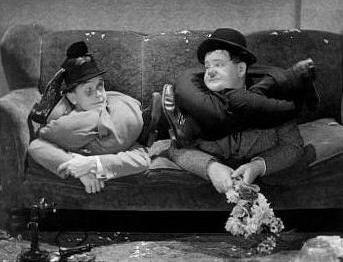 Shortly before the making of Going Bye-Bye! Stan was married for the second time, this time to a Virginia Ruth Rogers on the 3rd April. Possibly such an event reinvigorated the actor, because the synergy between Laurel and Hardy during Going Bye-Bye! is absolutely first-rate throughout. One particular scene perfectly encapsulates Hardy's character when he gets handed a jar of milk instead of a telephone to speak to Mae Busch. First Hardy attempts to pass it off nonchalantly with an inexplicable 'Excuse me please, my ear is full of milk', then he attempts to charm and ingratiate himself to the caller by waggling his tie at the phone... an action which she, of course, cannot see. It's the combination of affected pomposity combined with stupidity that delights... the desperation of a man determined to hang onto his dignity, completely unaware that he never had any in the first place. The increasing sophistication of the film-making technique can be witnessed here with the extensive use of tracking shots and an opening title sequence that's directly superimposed over the action. Finally, the short ends with one of Stan's 'body horror' endings... a returning Walter Long vows to Stan and Ollie that he'll wrap their legs around their necks and delivers on his promise.     (May/June 1934, 20m) Director: Charles Rogers Released: MGM, July 21, 1934 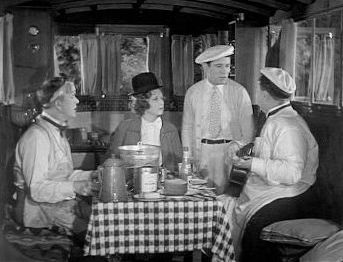 The alcohol prohibition of America that had begun in 1920 had been repealed during the making of Oliver The Eighth, making this the first Laurel and Hardy 'drinking' film to be made when the activity was no longer illegal. When Ollie's foot becomes riddled with gout he's advised by a Doctor to spend time in the mountains. Yet when Stan and Ollie get to the mountains they unwittingly drink from a well filled with illegal moonshine and become embroiled in a war of comic attrition with Charlie Hall. Having previously found that Laurel and Hardy in drunken hysterics is just as funny as Laurel and Hardy in reciprochal destruction mode, here they combine the two for added effect. The hyper-real world that Laurel and Hardy inhabit can be summed up in a scene where Charlie Hall attempts to set fire to Hardy's backside. Not only does Ollie stand there, motionless, waiting for him to do it, but when Stan advises a way to put the fire out Ollie first takes time to shake his hand and thank him for the advice before doing so. Perhaps the one thing that Them Thar Hills really lacks is a big enough pay off worthy of its escalating scope, and the short is perhaps one of the few that would warrant being a three-reeler. However, any feeling that the situations herein weren't fully explored could be put aside when six months later they began work on a sequel.     (December 1933-February 1934; July-October 1934, 77m) Director: Charles Rogers and Gus Meins Released: MGM, December 14, 1934 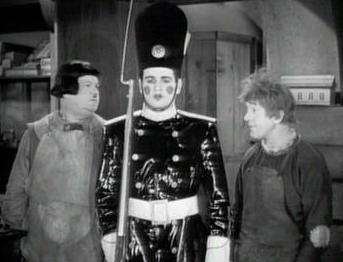 Babes In Toyland picks up where The Chimp left off, finally ensconcing Laurel and Hardy as family-friendly comedians, several worlds away from their bawdy silent screen personas. Ironically for such an ostensibly 'pure' film, it was the first real signs of cracks in the relationship between Stan and Hal Roach. Hal had bought the rights to the 1903 Operetta and set about writing a narrative during late 1933 through to early 1934, with Stan as Simple Simon and Ollie as the Pieman. Stan rejected the script, reputedly on the grounds that they couldn't wear their derby hats in the roles. This would seem to be something of a misremembered event on Roach's part, given that they'd previously appeared sans derbies in Fra Diavolo, and that they don't appear in hats in the final version of this film, either. Such facts get lost in the midst of failing memories and lack of recorded history, but what is known is that Stan repeatedly clashed with Roach over his treatment and longed to write his own version of the operetta. In Roach's own words for a 1991 South Bank Show special on Stan he recalled that 'Where the whole thing fell apart was when I bought this musical in New York and I got on the train to write the story of the musical. And when I got into the studio I was so pleased with everything of buying it and everything of the script, I called all the writers in.' After making such a public display of his script in front of his writing staff, Roach was angered to have it rejected by Laurel, observing that 'It finally got to the point where I said ''alright, you make it'' and I had nothing to do with it at all, and he made a lousy picture.' Whether Babes In Toyland is a 'lousy picture' is in the eye of the beholder, of course. Finally being filmed in August 1934, it was released in time for the Christmas market. While well produced, what may delight as a child can seem nauseatingly twee and saccharine to an adult and Babes In Toyland does have a cloying, self-conscious quality. Living in 'Toyland' as Stannie Dum and Ollie Dee, the two stars are not overgrown forces of nature, but instead almost fictionalised characters within a fantasy land, an environment where Stan falling out of a window is almost normal, rather than the usual uproarious misalignment of convention. No longer is Ollie the audience identifying everyman to whom fate deals continual misfortune, but a man in a wig and silly costume to whom misfortune must happen in order to make the movie operate as a filmic pantomime. Perhaps the worst moment occurs during the 'pee wee' sequence, where, upon Hardy boasting that he can do anything that 'Stannie' can do, he gets reminded of 'earsie kneesy nosey' and the finger wiggle from Fra Diavolo. Whereas before the reintroduction of previous routines in their movies had seemed alternately like reworking them for better effect or for a homage, this is the first time where it's used to directly reference the prior happening. The end result is that it doesn't get a laugh in and of itself, it's rather more like Laurel and Hardy giving themselves a pat on the back for past successes. Despite being a children's film it's also fairly violent on occasion, with the duo attacking enemies with darts and planning to murder villain Silas Barnaby with a rock. There's also more of Stan's playing with marriage conventions, as previously seen in Our Wife, where he milks the comic potential of Stan being married to another man. After tricking Silas into marrying him to spare Bo Peep, Stan then realises the consequences that he'll have to spend the rest of his life legally wed to the villain. When Stan later tells Ollie he's afraid to approach Barnaby and is reminded that he and Silas were close, Stan counters with 'Well that was before we were married.' There's even a later scene where much congratulatory kissing takes place and Stan, confused, kisses Ollie on the lips. Yet most notorious of all are the final scenes where bogeymen invade the village to steal women and children, scenes cut from some reissues after being deemed too scary. The bogeymen turn out not to be lisping New Yorkers but woolly-haired, bestial savages in tribal skirts. Their appearance is the sort of thing that would make you reach for an entire library of Kaplan and scratch your head in disbelief at Stan's mindset for including them. Although Babes In Toyland is much-loved by many, this addition is the final ignominy of a picture that's virtually a betrayal of everything Laurel and Hardy once stood for. If such a reaction seems extreme, then consider that just as the film was being completed, Stan's old roommate Charlie Chaplin was beginning pre-production on Modern Times. Although Stan and Ollie were never artists, their allusions to the Depression gave their work a level of integrity beyond its mainstream trappings. Here, however, it fully embraces the lowest common denominator...and, inexplicably, received some of the most positive reviews for a Laurel and Hardy film. Whatever the events in front of the camera, it seems the stars weren't aligned for Babes In Toyland. During production Hal Roach had his appendix removed, his wife and daughter were in a car crash, Stan fell off a set tearing ligaments in his leg and Henry Brandon, playing Silas Barnaby, was jailed for a week after being involved in a drunken fight. It also seems oddly appropriate that during Laurel and Hardy's most family-orientated picture the Hays Code of 1930 changed from guidelines and into being formally enforced. In June 1934 it was announced that any film released on or after 31st July 1934 would require a certificate of approval from the Production Code Administration before being released. In 1968 the Code finally gave way to a ratings system for movies that exists to this day, by which time Laurel and Hardy's career was long since over.   (October/November 1934, 21m) Director: Charles Rogers Released: MGM, December 8, 1934 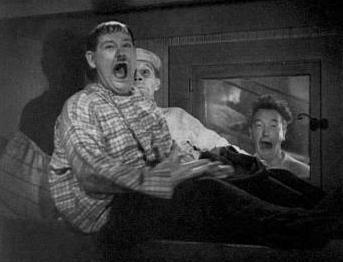 A return to more adult concerns, with seedy bars, violent brawls, embittered wives, alcoholics and Walter Long inflicting more bodily distortion. The Live Ghost sees Stan and Ollie earn money by tricking a bar full of men onto a ship that's believed haunted. Unfortunately for Stan and Ollie they end up shanghaied themselves, incurring the wrath of the crew, and then finally the captain (Long) when they mistakenly believe they've seen a ghost. Charles Rogers's direction is inventive in terms of angles and vision, and there's a pleasing artifice in the obviously fabricated world of run-down bars and an aged ship. But away from the technical level of the piece, a comedy film must stand or fall on whether or not it's funny. In that regard then The Live Ghost is more a likeable, amusing addition to the Laurel and Hardy canon rather than a minor classic. The egg breaking scenes delight, but beyond that it's a pleasant film rather than a stellar one.    (December 1934, 19m) Director: Charles Rogers Released: MGM, January 5, 1935 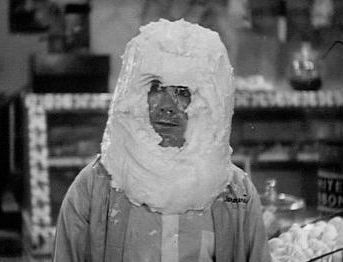 Their only short other than The Music Box to be Oscar-nominated, Tit For Tat missed out on winning, and so Stan had to wait until 1961 before he received a honorary Oscar for creative pioneering in the field of comedy. Tit For Tat was also the only Laurel and Hardy movie to directly reference another. While we're used to seeing 'Stan' and 'Ollie' in each picture, those characters can be married, rich, single, broke, or any number of combinations. Here though it's the same two guys that met Mae Busch and Charlie Hall in Them Thar Hills, a factor which means we don't have to bother with too much set-up and can go straight into the reciprocal destruction. The recreation of past glories is so blatant that there's even - probably coincidentally - a sign on Stan and Ollie's shop saying 'Open for Big Business'. With their shop next door to Hall's grocery store the two factions become embroiled in a petty war, which concludes without, like Them Thar Hills, a genuinely satisfactory pay-off. As a result the film doesn't feel like it has a beginning, middle and end, but is rather just the mid section alone. Add to this some shockingly poor lapses in shot continuity - even by Laurel and Hardy standards - and an unusually OTT, loud performance by Hardy and it's a short that isn't quite what it could be. Despite this, the sets are excellent, the direction imaginative and the general situation amusing. Two odd lines of dialogue see Stan listed as having had a nervous breakdown, and Ollie's declaration of the film's title to justify their extreme actions. In previous destructive encounters Stan and Ollie have been unwitting children becoming involved in escalating violence against their own judgement - or even, in the case of Big Business, actively revelling in it. But here they're fully cognisant of what they're doing, and even justifying it to themselves. The somewhat uneven nature of Tit For Tat can perhaps be explained by an insight into the improvisational technique given by Stan. While much of Laurel and Hardy's shorts contained ad-libs and the like, this is taken to the extreme here, as Stan wrote to a fan in 1959: 'we had a lot of fun on that film, we were behind on our schedule, so had to start shooting without a script & had to figure out the gags & routines as we went along. It was lucky it turned out as well as it did.'   
|
||||||||||||||||||||||||||||||||||||||||||||||||||||||||||||||||||||||||